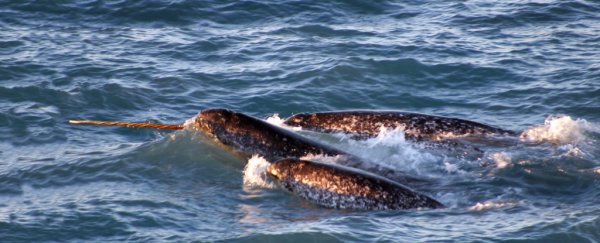Scientists have collected the most detailed recordings of narwhals to date, displaying a charming range of click, squeak, and buzz vocalisations that will help researchers understand these 'sea unicorns' like never before.
This information could help scientists predict how the East Greenland narwhals might be affected by an increase in human-made sounds in their waters, as climate change warms the ocean and opens the region to increased shipping.
"More ice-free water means easier access for vessels and industrial operations, such as exploration for oil and gas," said marine scientist Susanna Blackwell.
"The inhospitable pack-ice environment that is narwhals' home for much of the year has for millennia kept them in relative isolation - even from biologists. Now new amazing tools allow us to take a multi-day, virtual ride on the back of a narwhal!"
By attaching recording devices to wild narwhals, biologists obtained over 533 hours of recordings.
Previous surveys of narwhal sounds has been very limited, made by recordings on underwater microphones, or recording devices attached to whales using suction cups, which typically fall off in less than 24 hours.
But between 2013 and 2016, researchers from Greeneridge Sciences tagged six narwhals with Acousonde devices, which record not just sound, but also depth and orientation. They also tagged the whales with satellite tags for location tracking.
These were attached to the narwhals with suction cups, with nylon lines threaded through the dorsal ridge to keep the device in place if the suction cup failed. The Acousonde was attached to this line with magnesium links, which degraded after a few days so that the device would harmlessly fall away, allowing a team to retrieve it later using GPS.
This extra time was important, they found: the narwhals seemed subdued by the tagging experience, on average abstaining from making clicking and buzzing sounds for 23 hours after being released.
But the suction cup and nylon line system allowed the team to record pods of narwhals for days at a time, observing their vocal behaviour not just as it varied throughout the day, but also according to location as well.
They were able to record a total of 1,635 calls, made by the tagged whales and others of their kin swimming nearby.
Based on this rich sound library, the team figured out that there are three types of vocalisations narwhals make: clicks, buzzes, and calls.
Clicks and buzzes were made during echolocation for feeding, and buzzing typically occurred at depths of between 350 and 650 metres (1,150 and 2,130 feet).
Calls, on the other hand, were possibly used for communication purposes, and occurred at much shallower depths of up to 100 metres (330 feet), with over half of them occurring at less than 7 metres (23 feet).
They even noticed that some sounds appeared to identify what was probably a feeding area preferred by the animals - a particular fjord that had higher rates of buzzing than other locations.
The work provides a basic description of the narwhals' acoustic behaviour, and adds to a growing body that provides insights into their behaviour. Other recent discoveries include the violent use to which the whales put their idiosyncratic tusk, and the unique way they use their echolocation.
It will also serve as an excellent point of comparison for ongoing studies, particularly to determine behavioural changes as human activity increases.
"We … believe the records presented here are the longest obtained to date on free-ranging odontocetes," the researchers wrote in their paper.
"Such multi-day records are vital for describing aspects of a species' life history, foraging ecology, and habitat utilisation, and therefore also for assessing the whales' resilience to changes in their environment, such as those that may be brought on by changes in climate."
The research has been published in the journal PLOS One, and you can listen to a selection of the recordings here.
